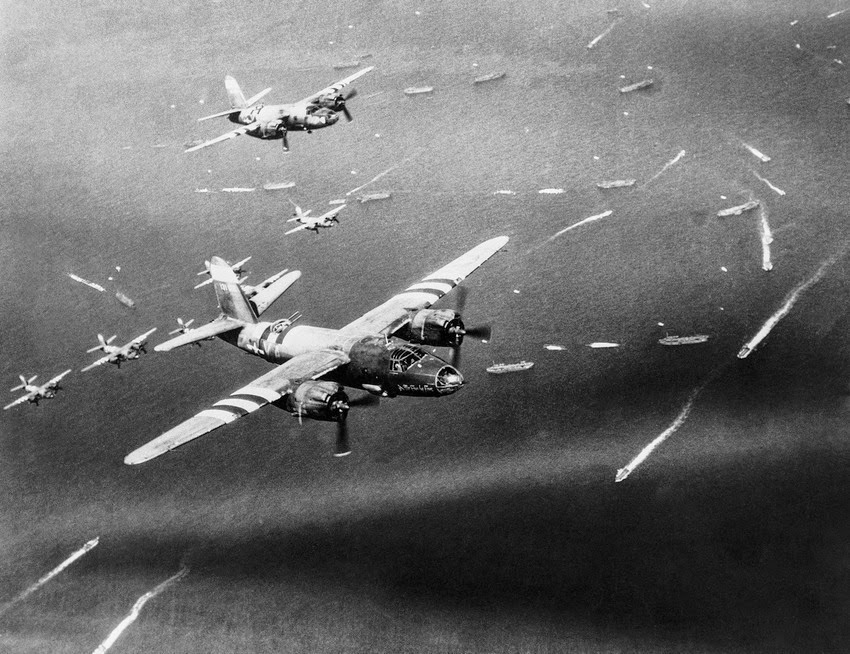Aerial bombing in Normandy
Air operations on 6 June 1944

American B-26 Marauder bombers fly over the Allied armada during Operation Neptune.
Photo: US National Archives
Before launching amphibious operations on the beaches, the Allies decided to organise a series of bombing raids on the coasts of northern France, in order to destroy a large number of strategic German military objectives, which, if they were in working order, would be capable of undermining such a landing operation.
Although the Atlantic Wall was still partly under construction on the Channel and Atlantic coasts, radar stations, numerous forts and coastal artillery batteries could disorganise the Allied offensive if nothing was done to eliminate these key points.
Allied bombing in northern France increased considerably from autumn 1943, in preparation for Operation Overlord, and the number of raids continued to rise until September 1944. The aim of these air operations was to disorientate the German forces by destroying not only military targets, but also roads, railways, stations, industries and port facilities. Supported by sabotage actions carried out by the French Resistance, the German communications network was to be severely handicapped.
- D-Day operations
In the early hours of 6 June 1944, in the middle of the night, the 8th and 9th Air Forces of the U.S.A.A.F. belonging to the 2nd Tactical Air Force, supported by British and Allied (and particularly French) bombers, were tasked, as part of Operation Neptune, with silencing all the important targets identified by reconnaissance aircraft in the months leading up to D-Day. 360 heavy bombers, supported by 269 light bombers, flew over the convoys of warships and transport ships heading for the Normandy coast.
These aircraft attacked the fortifications of the Atlantic Wall, despite the presence of numerous clouds, which made it difficult to spot the targets. 92 radar stations were bombed, from the tip of Barfleur to Le Havre, so that the Allied armada would not be noticed by Kriegsmarine radio operators. 74 stations were destroyed by the air force, making the operation a success.
But the bombardment of certain targets on the coast (artillery batteries, support batteries, fortified points) proved to be a relatively difficult operation.
The heavy cloud cover hampered the bombers’ crews. 67 of the bombers cancelled their missions because of the bad weather conditions, while the others tried as best they could to carry out their mission.
The coastline between Ouistreham in the east and Asnelles-sur-Mer in the west, i.e. all the beaches planned for the landing of Anglo-Canadian troops (Sword Beach in the east, Juno Beach in the centre and Gold Beach in the west), was bombed by Allied aircraft, and many targets were destroyed or damaged. The American beach sector of Utah was also heavily bombed, particularly the Cotentin coastal artillery batteries at Azeville and Crisbecq.
But between Longues-sur-Mer in the east and Grandcamp-Maisy in the west, the targets were hit very little, if at all, by the bombardments. A landing beach was located in this sector, Omaha Beach, where elements of the 1st and 29th American infantry divisions were due to land at dawn. According to reports from the various air groups deployed to bomb this sector, the presence of clouds complicated the task they had been given, and it only took a second or two for the bombs to be dropped several kilometres from their targets. The coastal artillery batteries near Longues-sur-Mer and Maisy, for example, remained virtually intact despite the bombardment, as did the 8 fortified points on Omaha Beach. The Allies did not know it at the time, but the Germans suffered no damage in this sector: the installations of the Atlantic Wall at Omaha Beach had suffered little or no damage.
- Bombing toll
Since May 1944, bombing raids on the north-western quarter had increased, mainly targeting road and rail targets.
With the help of the destruction carried out by the French resistance, the Allies launched a large number of raids over Normandy, which resulted in relatively little destruction for the resources involved. Some sites were crushed under the bombs, while others were never even scratched. These disparities were felt in the hours following the bombardments, when the Allied troops landed facing the Atlantic Wall, which was supposed to have been largely destroyed, but which in places was still in perfect condition.
![]() Back to Airborne operations menu
Back to Airborne operations menu
